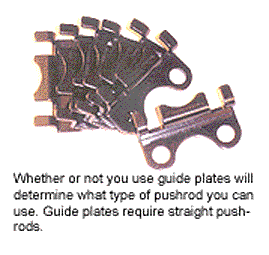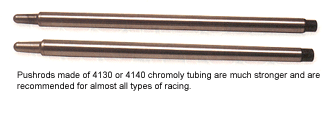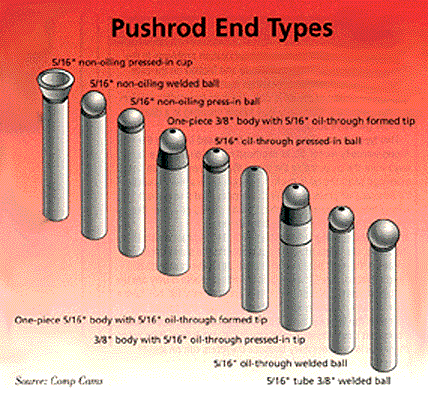Pushrods are the weakest link in the upper valvetrain. Pushrods transfer and redirect the upward motion of the lifters, which goes in one direction, to the rocker arms which move in another direction. Consequently, they are subjected to bending forces as the load and engine speed increases.
For stock engines, mild steel stock pushrods are more than adequate. But for performance applications with stiffer valve springs and higher valvetrain loads, significantly stronger, stiffer pushrods are needed to withstand the punishment.
Terry Manton of Manton Pushrods, Lake Elsinore, CA, says compression and deflection are the two fundamental forces pushrods must withstand in racing. Pushrods deflect under high loads because of differences in angularity between the lifters and the cups or adjustment screws in the rocker arms. Oblique angles contribute to side-loading that leads to deflection if the pushrod is not rigid enough to remain straight. If the pushrod deflects, it reduces net lift at the valve, which hurts breathing and the engine’s power potential. It also shortens valve duration and retards valve timing.

Manton says most of the deflection occurs at the lower end of the pushrod where the side loads are typically the greatest. He recommends going with larger diameter pushrods (his company makes ones up to 9/16? in diameter!) and/or using pushrods with a heavier wall thickness (.120? up to .188?). The pushrods must also be made of a stronger material. Stock pushrods are typically made of 1018 steel tubing, which is not strong enough for springs that have more than 400 psi of open pressure, or engines that exceed 7,000 rpm. Pushrods made of 4130 or 4140 chromoly tubing are much stronger and are recommended for almost all types of racing.
Chromoly 4130 is a tough material with a tensile strength that varies from 140,000 psi up to 240,000 psi depending on the heat treatment. For all out racing applications such as Top Fuel, Pro Stock, Pro Modified, Blown Alcohol, NASCAR Cup racing, marine racing and tractor pulling, 4140 chromoly tubing can provide up to 275,000 psi of tensile strength.
Pushrod deflection can also be reduced by using single taper or offset dual taper pushrods. The thickest part of the pushrod should be positioned closest to the lifters to take advantage of the larger cross-section. Manton says it is especially important to use tapered pushrods in engines that are equipped with roller lifters, increased valve lash, high ratio rocker arms, double or triple springs and operate at high rpm.
“Weight is not as much of a concern as many people think it is,” says Manton. “The difference between a stock 5/16? diameter pushrod in a small block Chevrolet and a 7/16? to 3/8? taper pushrod represents a difference of approximately 2.5 percent of effective weight. This is because the pushrod is on the slow side of the valvetrain. The effective increase in weight between the two pushrods is small but provides a huge increase in valvetrain stability. The valve side of the valvetrain is the critical side where any weight savings will make marked improvements.”
Something else to consider when choosing pushrods is whether the engine has guide plates or not. Pushrods that are used with guide plates must be hardened to withstand wear. Guide plates also require straight pushrods.

Manton says he custom makes all his pushrods to order. The tips are CNC machined in house to ensure quality and are made from high impact, wear resistant 8620 barstock that is case hardened, cryogenically treated and tempered, or H13 tool steel that is heat treated and salt nitrided.
Dennis Marshall of Smith Brothers, Bend, OR, is another custom manufacturer of high performance pushrods. “The number one misconception engine builders have about pushrods is that lighter is better. That’s absolutely wrong! The last thing you want to be concerned with is weight. If the pushrods are too light duty, they will deflect or bend and cost you horsepower.”
Marshall says a lot of engine builders say they want 5/16? thinwall pushrods for hydraulic lifters, thinking lighter pushrods are the way to go. But the smaller size does not work very well in performance applications because they deflect too much. He says you can actually see the pushrods flexing if you watch the engine while it is running on a valvetrain dyno.

“We sell a 7/16? diameter pushrod with a .120? wall thickness for hydraulic and solid roller lifters. It is a very strong pushrod and works great in the most demanding applications. We also make pushrods up to 1/2? diameter with the .120? wall thickness, which are being used in more and more racing applications. Professional race teams are running the heavier wall pushrods to eliminate deflection.”
Marshall explains on Chrysler applications with ball and cup pushrods, correct geometry is very important. If the pushrods are too long, the cup will sit above the oil hole screw and they will burn up the cups. If they are too short, the angle of the adjusting screw to the pushrods becomes severe and you can get into a bind situation and break cups or adjusters. He says Chryslers have an oiling problem so it’s important to use good quality adjuster screws with proper hardening and radius. “On our pushrods, we maintain our radius tolerances to less than plus .0012? and minus .0023?. We also use 4130 chromoly tubing that is heat treated and case hardened to Rockwell 60 RC for guide plate applications, or RC 42 for non-guide plate applications.”
Marshall says he also custom builds pushrods to order, and can inspect and straighten used Smith Bros. pushrods for customers, also. “In addition to competition applications, we produce a lot of custom pushrods for antique and agricultural engines.”
Determining The Correct Length
The length of a pushrod may vary from stock dimensions depending on the base circle of the camshaft, the height and location of the lifters, whether the pushrod cups in the lifters are offset or centered, the location of the pushrod cups or adjuster screws in the rocker arms, the geometry of the rocker arms and rocker arm ratio, the installed height of the valves, and how much the heads or block have been milled.
Russ Flagel of Indy Cylinder Heads, Indianapolis, IN, a builder of custom pushrods mostly for Chrysler applications, says the only person who can accurately determine pushrod length is the person who has all the parts to assemble – in other words, they guy who is building the engine.
With so many variables, it’s important to get the correct length pushrods so the tips of the rockers will be properly positioned on the tops of the valve stems. If the geometry is off, the rocker arms can push the valve stems sideways causing abnormal loading and wear. If the pushrods are too long, the valve spring coils may bottom out and bind, causing damage to the valvetrain.
Determining the correct length of a pushrod can be tricky, so many pushrod suppliers recommend purchasing an adjustable “checking” pushrod, installing it and then measuring the pushrod’s length before ordering a full set of custom length pushrods. All the pushrod manufacturers we interviewed for this article said it’s very important to make sure all the valve stems are trimmed so the installed height of all the valves are the same – otherwise you’ll end up requiring a different length pushrod for each valve.
The method you use to determine the overall length of a pushrod is also important because methods vary. With pushrods that have balls at both ends, the length can be measured end to end. You can use the actual length as measured, but remember that the overall measurement will be affected by the size of the oil holes in the end of the pushrod. Because of this, some people use the “theoretical length” of the pushrod as if the oil holes were not there. Determining the theoretical length requires using a special gauge that compensates for the oil hole, or estimating the amount the oil hole reduces the ball radius at the ends of the pushrod (figure .017? less for a .100? oil hole in the end of a 5/16? pushrod).
With pushrods that have a cup at the top end, the overall length of the pushrod can be measured – but you’ll also have to determine the “effective length” of the pushrod by measuring the depth of the cup and subtracting it from the overall length. This can be done by placing a ball in the cup, measuring the overall length of the pushrod with the ball in place, then subtracting the diameter of the ball.
Whatever method you use, make sure you and your pushrod supplier are on the same page and they understand which method you used to determine length. The supplier may also need to know how much spring pressure the engine has so the pushrods will have sufficient strength to handle the load.
Another variable is the radius of the balls at the ends of the pushrod. This may vary depending on the type and brand of rocker arms used. Measuring the radius requires special gauges, or obtaining the required radius dimensions from the rocker arm supplier.
Installation Tips
The best advice for selecting performance pushrods is to use the largest, stiffest, strongest pushrods that will physically fit the motor. As a rule, you only need to allow about .010? of clearance at the closest spot for the pushrods. This will determine the maximum diameter pushrods that can be used as well as single or double taper.
Also, don’t worry about the weight. Thicker wall pushrods are much stronger than thin wall pushrods and will be less apt to deflect under extreme loads and speeds. The added weight will have little effect on the valvetrain’s rpm potential and will actually improve power by maintaining a rigid column between the lifter and rocker arm.
Tapered pushrods should be used where possible (especially in high load, high rpm engines) but not in guide plate applications. Straight hardened pushrods should only be used with guide plates.
Make sure there is plenty of oil flow through the lifters and pushrods to the rocker arms. With high lift cams, it may be necessary to modify the oil hole in the lifter cup so oil is not cut off at maximum lift.
If pushrods are being reused, they should be inspected with a magnetic particle inspection machine to check for cracks, and checked for straightness. If bent, the pushrods should be replaced or returned to the manufacturer for straightening (if possible).
If an engine has experienced repeated pushrod failures, it may indicate one of two things: physical interference in the valvetrain (too much valve lift and/or insufficient valve spring clearance), or excessive deflection in the pushrods. The former requires checking clearances and machining as needed to provide the necessary clearance, while the latter indicates a need for stronger, stiffer pushrods.
LIFTERS & CAMS
Cam failures can occur if there are lubrication problems in the engine. Lifters create a lot of pressure and friction on the cam lobes, so the lobes and cam bearings must receive lots of oil. If oil pressure is low or the oil is dirty, the cam may suffer accelerated lobe wear and ultimately lobe failure resulting in a dead cylinder (no valve action).
This type of cam damage can also be caused by using the wrong viscosity motor oil. In overhead cam engines, it’s a long ways from the oil pump to the top of the cylinder head. On cold mornings when the oil is thick, it can take quite a few seconds for adequate oil pressure to reach the cam. That’s why most vehicle manufacturers recommend using 5W-30 oil rather than 10W-30 or 10W-40 for cold weather driving.
If an engine is being reassembled with the original camshaft and lifters, the lifters must be put back into the same bores as before so the wear patterns will match up. If the camshaft is being replaced, new lifters should be installed also if they are the flat tappet variety. Flat bottom lifters are not really flat but have a slight convex curvature so the lifter will rotate and spread the wear over the lifter surface. If the lifter doesn’t spin due to wear, it can wear down the cam lobe causing a cam failure. With roller lifters this is not necessary because the lifters run on low friction rollers.
The type of lifters used can also affect the effective lift and duration of a cam. Some aftermarket street performance lifters are designed to “leak down” and reduce lift and duration at low rpm to improve low end torque and throttle response.













